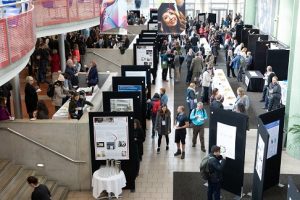 Some 365 leading researchers responsible for the care of natural history collections descended on Dunedin in August for a first-ever event in the Southern Hemisphere. The 33rd annual meeting of the Society for the Preservation of Natural History Collections (SPNHC) and the Biodiversity Information Standards community (Taxonomic Database Working Group – TDWG) met together for the first time.
Some 365 leading researchers responsible for the care of natural history collections descended on Dunedin in August for a first-ever event in the Southern Hemisphere. The 33rd annual meeting of the Society for the Preservation of Natural History Collections (SPNHC) and the Biodiversity Information Standards community (Taxonomic Database Working Group – TDWG) met together for the first time.
More than 300 abstracts were submitted for the conference, with delegates attending from all over the world. The theme of the meeting was “Collections and Data in an Uncertain World”; exploring strategies that may mitigate risks to the world’s ‘libraries of life’; both the physical collections held in museums, herbaria and research institutions and the data derived from them.
The event pooled Dunedin’s first-class knowledge in the field, with the co-located Otago Museum and the University of Otago providing both organisational and venue support.
Robert Morris, Director of Collections, Research & Education at Otago Museum, said: “Given its geology and indeed its bicultural approach, New Zealand had much to contribute in areas of disaster planning and indigenous knowledge.” This included plenary sessions from Canterbury Museum Director Anthony Wright on the impact of the Christchurch earthquakes on the museum; and Dr Priscilla (Cilla) Wehi, a conservation biologist and Rutherford Discovery Fellow at Manaaki Whenua Landcare Research in Dunedin.
Morris adds: “The conference has certainly put Dunedin on the international map in terms of natural science collections and bioinformatics and the benefits for the New Zealand community, attracting as it did specialists from around the world, was huge.”
The event also brought an estimated economic benefit to Dunedin of $630,000 in the form of accommodation, tourism, tours and shopping. The benefits extended throughout the country, too; with 80 percent of the delegation coming from abroad, many attendees chose to stay on after the conference to see more of New Zealand.
Future collaboration
Morris is positive about the longer-term outcomes of hosting the conference, too. “Perhaps most importantly of all was the opportunity for people from this part of the world to share in the developments taking place overseas and to realise that the issues confronting natural history collections and allied data in this country are not so very different from those faced by many around the world. We are all global citizens with a shared responsibility for understanding and caring for our natural world.
“The meeting recognised the fragmented landscape in New Zealand and Australia. A focus for the conference was to garner interest and feedback on forming a local branch or affiliation that would facilitate greater communication and information sharing at either a national or Oceania level. The meetings that were held were very positive and we are now looking to the next steps towards forming an effective working group for Australasia/Oceania. There are real benefits from working as a united voice, from professional development to lobbying.”

Moreover, despite the initial challenges of managing different conference traditions and multiple parallel sessions, both SPNHC and TDWG felt that the joint conference was a success. Both organisations believe that future joint conferences, perhaps every five years, would be beneficial.
Dunedin on exhibition
The Local Organising Committee was made up of key members from SPNHC and TDWG, with Otago Museum staff acting as the primary organisers for the conference and putting Dunedin at the centre of proceedings. All plenary sessions, workshops and break-out sessions were held on Otago University Campus, with evening events and some sessions held at the Otago Museum.
The conference dinner was held in the Business School on campus and included a performance by a local kapa haka group, providing a New Zealand atmosphere and welcome for the international delegates.
Social events included a welcome reception held in the Museum’s expansive atrium, with the museum’s 150th anniversary exhibition, Est.1868, open for delegates. The sponsors’ cocktail evening was also held in the Museum, in the recently opened Tūhura Otago Community Trust Science Centre. The novelty and fun of the spaces proved a great success, receiving very positive feedback.
Additional field trips made the most of Dunedin’s unique features aligned to the conference content. These included a tour of Orokonui Ecosanctuary, home to native flora, fauna and endangered species; and a wildlife cruise around Otago Peninsula, including views of the only mainland nesting place of Northern Royal Albatross in the world.

Excellent support
A local professional conference organiser (PCO) was contracted to undertake the online registrations process, organise conference bags, and to field enquiries during the conference itself. When a concert was announced by popstar Pink over the same period as the conference, and accommodation became scarce, the PCO helped to source additional rooms, although delegates also found accommodation through Airbnb and other sites.
The event also managed to secure approximately NZ$50,000 in sponsorship, with a number of prior sponsors of SPNHC or TDWG keen to continue their support.
Morris adds that initial government support to bring the event to New Zealand had helped make the whole thing possible: “Tourism New Zealand’s Conference Assistance Programme was excellent. We first approached them in 2016 when we were considering preparing a bid to SPNHC. They provided funds to allow us to pitch at the Berlin conference in 2016 and greatly assisted with the design and production of a beautiful presentation booklet. They also assisted with the design and development of our PowerPoint presentation. That our bid was successful was in large part due to Tourism New Zealand’s assistance.”















